#255: Learning about Legged Locomotion from Birds, with Monica Daley
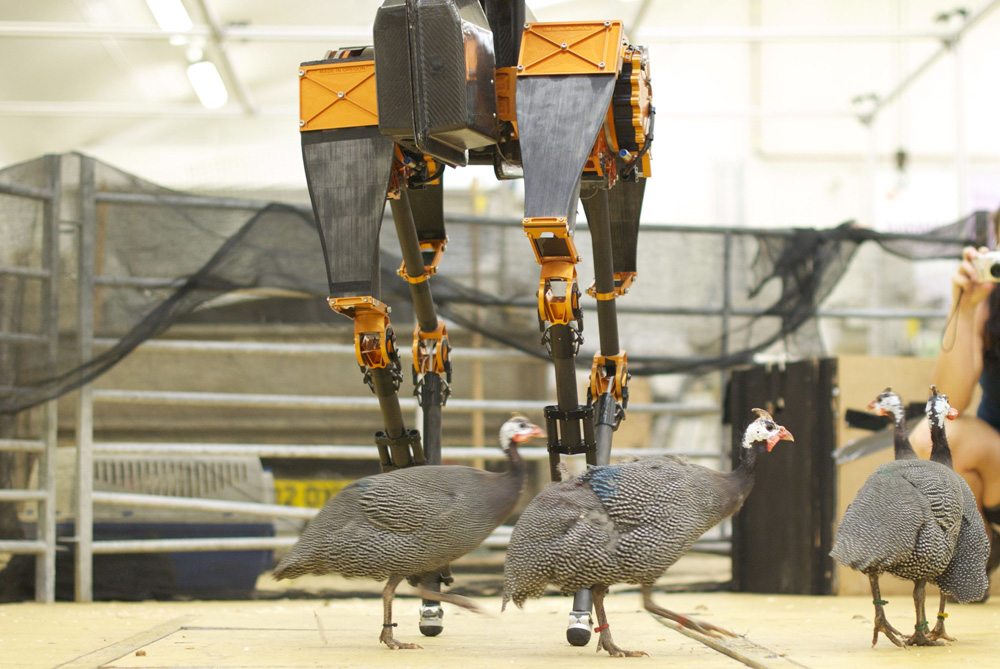
In this episode, Audrow Nash speaks with Monica Daley about learning from birds about legged locomotion. To do this, Daley analyzes the gaits of guineafowl in various experiments to understand the mechanical principles underlying gaits, such as energetic economy, mechanical limits, and how the birds avoid injury. She then tests her ideas about legged locomotion on legged robots with collaborators, including Jonathan Hurst from Oregon State University. Daley also speaks about her experience with interdisciplinary collaborations.
Monica Daley
 Monica Daley earned an HBSc in Biology with a Chemistry minor at the University of Utah, where she was inspired to pursue an academic career through her research on human locomotor-ventilatory integration with Dennis Bramble and David Carrier. Daley then spent a year as a research technician at the University of Utah, investigating motor control of singing in zebra finches in the lab of Franz Goller. These experiences initiated a long-standing fascination with the interplay of mechanics and neural control.
Monica Daley earned an HBSc in Biology with a Chemistry minor at the University of Utah, where she was inspired to pursue an academic career through her research on human locomotor-ventilatory integration with Dennis Bramble and David Carrier. Daley then spent a year as a research technician at the University of Utah, investigating motor control of singing in zebra finches in the lab of Franz Goller. These experiences initiated a long-standing fascination with the interplay of mechanics and neural control.
Daley went on to Harvard University, where she earned her MA and PhD in Organismic and Evolutionary Biology. Her research on muscle-tendon dynamics and biomechanics of avian bipedal locomotion was supported by a prestigious Predoctoral Fellowship award from the Howard Hughes Medical Institute and supervised by Andrew Biewener at the Concord Field Station of Harvard University (CFS Website).
After completing her PhD, Daley was awarded a Research Fellowship by the U.S. National Science Foundation to develop models of the dynamics and control of bipedal locomotion, working with Dan Ferris in the Human Neuromechanics Lab at University of Michigan, in collaboration with Auke Ijspeert in the Biologically Inspired Robotics Group at the Swiss Federal Institute of Technology in Lausanne.
Daley is a faculty member of the Structure and Motion Lab, where she leads research in Comparative Neuromechanics— a field that seeks to understand the interplay of morphology, mechanics and sensorimotor control that influences how animals move through their environment.
Links
Soft robots that can sense touch, pressure, movement and temperature
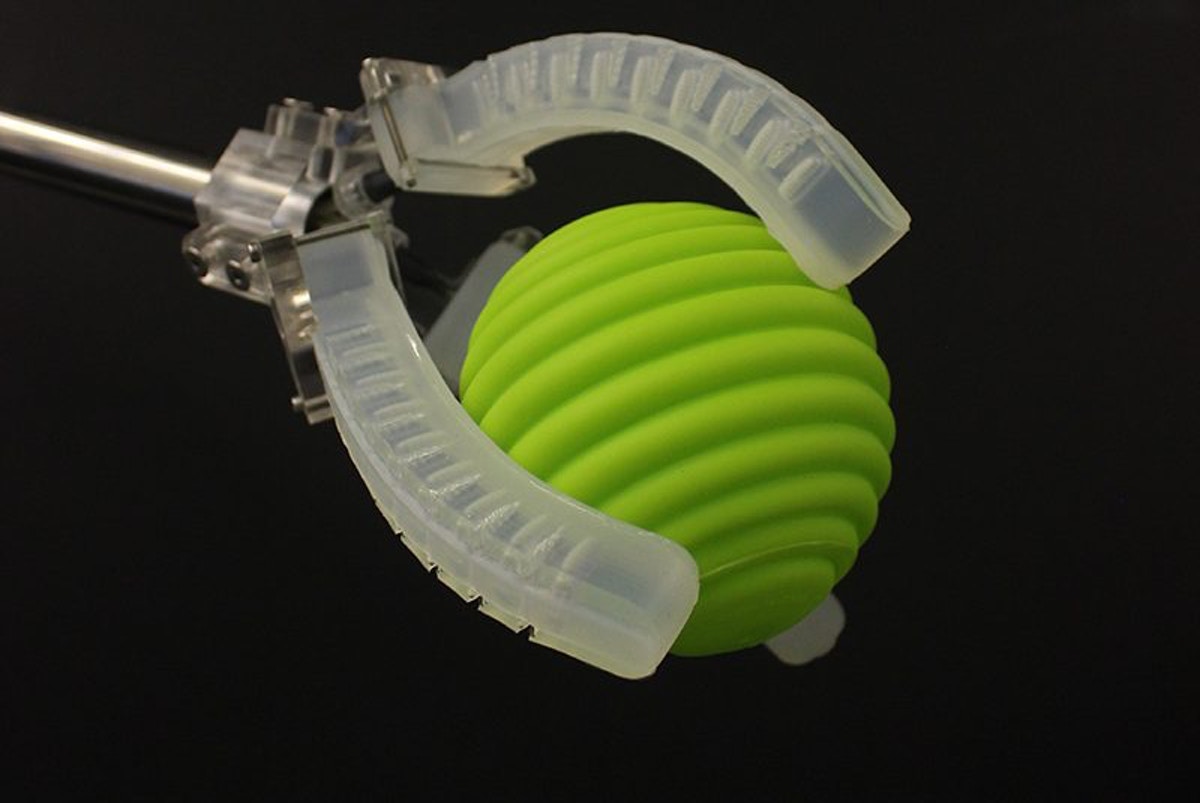
By Leah Burrows
Researchers at Harvard University have built soft robots inspired by nature that can crawl, swim, grasp delicate objects and even assist a beating heart, but none of these devices has been able to sense and respond to the world around them.
That’s about to change.
Inspired by our bodies’ sensory capabilities, researchers at the Wyss Institute for Biologically Inspired Engineering and the Harvard John A. Paulson School of Engineering and Applied Sciences have developed a platform for creating soft robots with embedded sensors that can sense movement, pressure, touch, and even temperature.
The research is published in Advanced Materials.
“Our research represents a foundational advance in soft robotics,” said Ryan Truby, first author of the paper and recent Ph.D. graduate at SEAS. “Our manufacturing platform enables complex sensing motifs to be easily integrated into soft robotic systems.”
Integrating sensors within soft robots has been difficult in part because most sensors, such as those used in traditional electronics, are rigid. To address this challenge, the researchers developed an organic ionic liquid-based conductive ink that can be 3D printed within the soft elastomer matrices that comprise most soft robots.
“To date, most integrated sensor/actuator systems used in soft robotics have been quite rudimentary,” said Michael Wehner, former Postdoctoral Fellow at SEAS and co-author of the paper. “By directly printing ionic liquid sensors within these soft systems, we open new avenues to device design and fabrication that will ultimately allow true closed loop control of soft robots.”
Wehner is now an Assistant Professor at the University of California, Santa Cruz.
To fabricate the device, the researchers relied on an established 3D printing technique developed in the lab of Jennifer Lewis, Sc.D., Core Faculty Member of the Wyss Institute and the Hansjörg Wyss Professor of Biologically Inspired Engineering at SEAS. The technique — known as embedded 3D printing — seamlessly and quickly integrates multiple features and materials within a single soft body.
“This work represents the latest example of the enabling capabilities afforded by embedded 3D printing – a technique pioneered by our lab,” said Lewis.
“The function and design flexibility of this method is unparalleled,” said Truby. “This new ink combined with our embedded 3D printing process allows us to combine both soft sensing and actuation in one integrated soft robotic system.”
To test the sensors, the team printed a soft robotic gripper comprised of three soft fingers or actuators. The researchers tested the gripper’s ability to sense inflation pressure, curvature, contact, and temperature. They embedded multiple contact sensors, so the gripper could sense light and deep touches.
“Soft robotics are typically limited by conventional molding techniques that constrain geometry choices, or, in the case of commercial 3D printing, material selection that hampers design choices,” said Robert Wood, Ph.D., Core Faculty Member of the Wyss Institute and the Charles River Professor of Engineering and Applied Sciences at SEAS, and co-author of the paper. “The techniques developed in the Lewis Lab have the opportunity to revolutionize how robots are created — moving away from sequential processes and creating complex and monolithic robots with embedded sensors and actuators.”
Next, the researchers hope to harness the power of machine learning to train these devices to grasp objects of varying size, shape, surface texture, and temperature.
The research was coauthored by Abigail Grosskopf, Daniel Vogt and Sebastien Uzel. It was supported it part by through Harvard MRSEC and Harvard’s Wyss Institute for Biologically Inspired Engineering.
Robotics fundings, acquisitions, IPOs, failures: February 2018

Nineteen different startups were funded in February, raising $377 million; a substantial two-month start for the new year. Five acquisitions were reported during the month, while the IPO front had no activity whatsoever.
CB Insights said that China dominated the funding of AI-related startups during 2017. So far in 2018, the China funding percentage appears to be less than the 48% of 2017.
Robotics Fundings
1. PROCEPT BioRobotics, a Redwood Shores, Calif.-based surgical robotics company, raised $118 million in financing. Viking Global Investors LP led the round, and was joined by investors including Perceptive Advisors and CPMG Inc. More Coverage on The Robot Report
2. Aurora Innovation, a Silicon Valley self-driving vehicle startup, raised $90 million in funding. Investors include Greylock Partners and Index Ventures.
3. Rani Therapeutics, a Silicon Valley medical device startup, raised $53 million raising their total funding to $142 million. The round included Chinese GeneScience Pharmaceuticals, Shire, Bossa Ventures, and Cathay Venture, GV, Novartis, AstraZeneca, Ping An Ventures, Virtus Ventures and others. More Coverage on The Robot Report
4. DecaWave, a Dublin, Ireland-based fabless semiconductor company specializing in precise location and connectivity applications, raised $30 million in funding. Atlantic Bridge Ventures led the round, and was joined by investors including Enterprise Ireland, China Ireland Growth Technology Fund, ACT Venture Capital and ZZ Ventures.
5. Magazino, a Munich startup providing mobile picking robots for small and medium-sized boxes, cases and pods, raised $24.8 million in a round led by the Körber Group with participation by Cellcom Resources, Zalando and Fiege Logistics.
6. CommonSense Robotics, an Israeli startup integrating robotics with online grocery fulfilment, raised $20 million in a Series A funding led by Playground Global, with participation from Aleph VC and Eric Schmidt’s Innovation Endeavors. CommonSense employs robots to power custom warehouses or micro-fulfilment centers that are small enough to be placed in urban areas. The robots are designed to store products and bring the right ones to humans who then pack a customer’s order. More robots are then used to get the packaged order out to dispatch.
7. Prophesee SA, a Paris-based creator of a bio-inspired vision system, raised $19 million in funding. Investors include 360 Capital Partners, Supernova Invest, iBionext, Intel Capital, Renault Group and Robert Bosch Venture Capital.
8. Citadel Defense Company, a San Diego-based drone system developer, raised $12 million in Series A funding. Investors include Lightspeed Venture Partners.
9. Drone Base, a Los Angeles startup that connects drone users with commercial tasks, raised $12 million in a Series B funding round co-led by Upfront Ventures and Union Square Ventures. DJI, Hearst Ventures and Pritzker Group also participated in the round.
10. May Mobility, an Ann Arbor-based startup developing self-driving shuttles for large campuss and central business districts, raised $11.5 million in seed funding from Toyota AI Ventures and BMW i Ventures. More Coverage on The Robot Report
11. Miso Robotics, a Pasadena, CA food handling robot startup, raised $10 million in a Series B round led by Acacia Research Corporation, with participation from Levy Restaurants, OpenTable CTO Joseph Essas, and Cali Group, owner of CaliBurger. Miso Robotics is one of a number of companies trying to use robots to replace or augment fast food workers.
12. inVia Robotics, a Westlake Village, Calif.-based provider of robotics warehouse automation solutions for e-commerce fulfillment centers, raised $9 million in funding. Upfront Ventures led the round and was joined by investors including Embark Ventures.
13. EdgyBees, a CA startup providing augmented reality for drones and other moving platforms, raised $5.5 million in a seed round led by OurCrowd with participation from 8VC, Verizon Ventures, Aspect Ventures, Motorola Solutions Ventures and NFX.
14. Fourier Intelligence, a Chinese startup providing exoskeletons for rehab and prosthetics, raised $4.7 million in a Series A round let by Prosperico Venture with participation from Volcanics Venture, IDG Capital Partners and Qianhai Fund of Funds.
15. Invert Robotics, a NZ RaaS (robotics as a service) startup providing inspection of industrial equipment across a range of applications, raised $4.6 million (6.4 NZ$) from Powerhouse Ventures, NZ Venture Investment Fund and Allan Moss.
16. American Robotics, a Boston-based startup developing a drone system for farmers, has raised $2 million in a second seed round (they raised $1.1 million last year). Investors included BRC Innovation and Brain Robot Capital.
17. Dash Robotics, a Silicon Valley startup developing futuristic, app-controlled toy robots, raised $2.7 million in a Series A funding round led by Ironfire Ventures.
18. Planys Technologies, an Indian marine robotics startup, raised $1 million from Kris Gopalakrishnan along with Pratithi Investment Trust and MEMG (Manipal Education and Medical Group).
19. Solinftec, a Brazilian ag tech startup, raised an undisclosed Series B funding from AgFunder and TPG ART.
Acquisitions
1. KBR, a large engineering and construction company formerly owned by Halliburton, acquired Stinger Ghaffarian Technologies, an integrator of space and defense systems, from the government for $355 million.
2. Fanuc acquired Japanese co-bot maker Life Robotics for an undisclosed amount.
3. Humatics, a Cambridge, MA startup developing a localization platform, has acquired 5D Robotics, a Carlsbad, CA provider of mobility products using radio waves for distancing, and 5D’s subsidiary, Time Domain, an Alabama provider of ultra-wide-band chips, for an undisclosed amount. More Coverage on The Robot Report
4. Johnson & Johnson Medical Devices acquired Orthotaxy, a French developer of software-enabled surgery technologies, including a differentiated robotic-assisted surgery solution for total and partial knee replacement. Financial terms of the transaction were not disclosed. More Coverage on The Robot Report
5. FarmShots, a NC startup providing imagery and analytics for farmers, was acquired by Syngenta for an undisclosed amount. FarmShots collects data for 8 million acres.
IPOs
Nada. Zip. Zero!
Failures
1. New Matter, a Pasadena-based maker of 3D printers is closing down after running out of the $6.5 million funding it had raised. It will continue to maintain printers it has sold to consumers and schools through the summer of 2018.

2. RoboBusiness Europe, a trade conference and expo scheduled to be held in February by the same group that produces RoboBusiness in America, cancelled due to lack of funding.
3. Innorobo, a service robotics expo and conference to be held in June has also been cancelled due to a lack of funding.
Robots in Depth with Jana Tumova

In this episode of Robots in Depth, Per Sjöborg speaks with Jana Tumova, Assistant Professor at the KTH Royal Institute of Technology, about formal verification of computer systems and synthesizing controllers from models.
We get an introduction to the relatively new, especially when applied to robotics, field of formal verification. Jana talks about the requirements and limits of formal verification and how she feels we are ready to start merging the computer science process with regulatory and business processes.
Beware of replicating sexism in AI, experts warn
Conventional vs. Robotic Palletizing
Investing in Robotics
Shortage of Professional Welders Leaves Room for Robots in the Field
World’s First Self-driving, Commercial-class Snow Clearing Robot from Left Hand Robotics Operating at Pilot Customer Locations Across North America
Snake-inspired robot uses kirigami to move
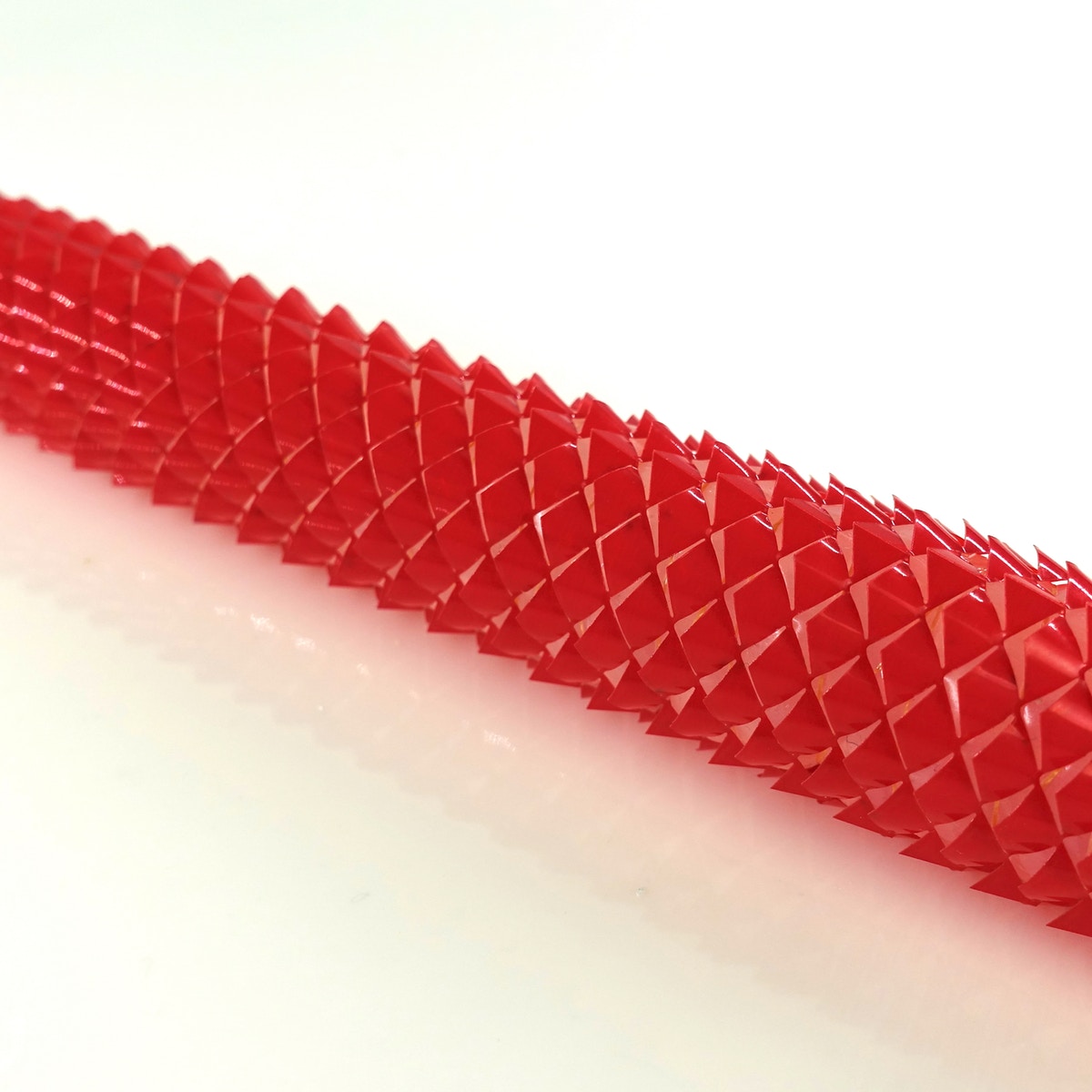
By Leah Burrows
Who needs legs? With their sleek bodies, snakes can slither up to 14 miles-per-hour, squeeze into tight spaces, scale trees, and swim. How do they do it? It’s all in the scales. As a snake moves, its scales grip the ground and propel the body forward — similar to how crampons help hikers establish footholds in slippery ice. This so-called “friction-assisted locomotion” is possible because of the shape and positioning of snake’s scales.
Now, a team of researchers from the Wyss Institute at Harvard University and the Harvard John A. Paulson School of Engineering and Applied Sciences (SEAS) has developed a soft robot that uses those same principles of locomotion to crawl without any rigid components. The soft robotic scales are made using kirigami — an ancient Japanese paper craft that relies on cuts, rather than origami folds, to change the properties of a material. As the robot stretches, the flat kirigami surface is transformed into a 3D-textured surface, which grips the ground just like snake skin.
The research is published in Science Robotics.
“There has been a lot of research in recent years into how to fabricate these kinds of morphable, stretchable structures,” said Ahmad Rafsanjani, Ph.D., a postdoctoral fellow at SEAS and first author of the paper. “We have shown that kirigami principles can be integrated into soft robots to achieve locomotion in a way that is simpler, faster, and cheaper than most previous techniques.”
The researchers started with a simple, flat plastic sheet. Using a laser cutter, they embedded an array of centimeter-scale cuts, experimenting with different shapes and sizes. Once the sheet was cut, the researchers wrapped it around a tube-like elastomer actuator, which expands and contracts with air like a balloon.
When the actuator expands, the kirigami cuts pop out, forming a rough surface that grips the ground. When the actuator deflates, the cuts fold flat, propelling the crawler forward.
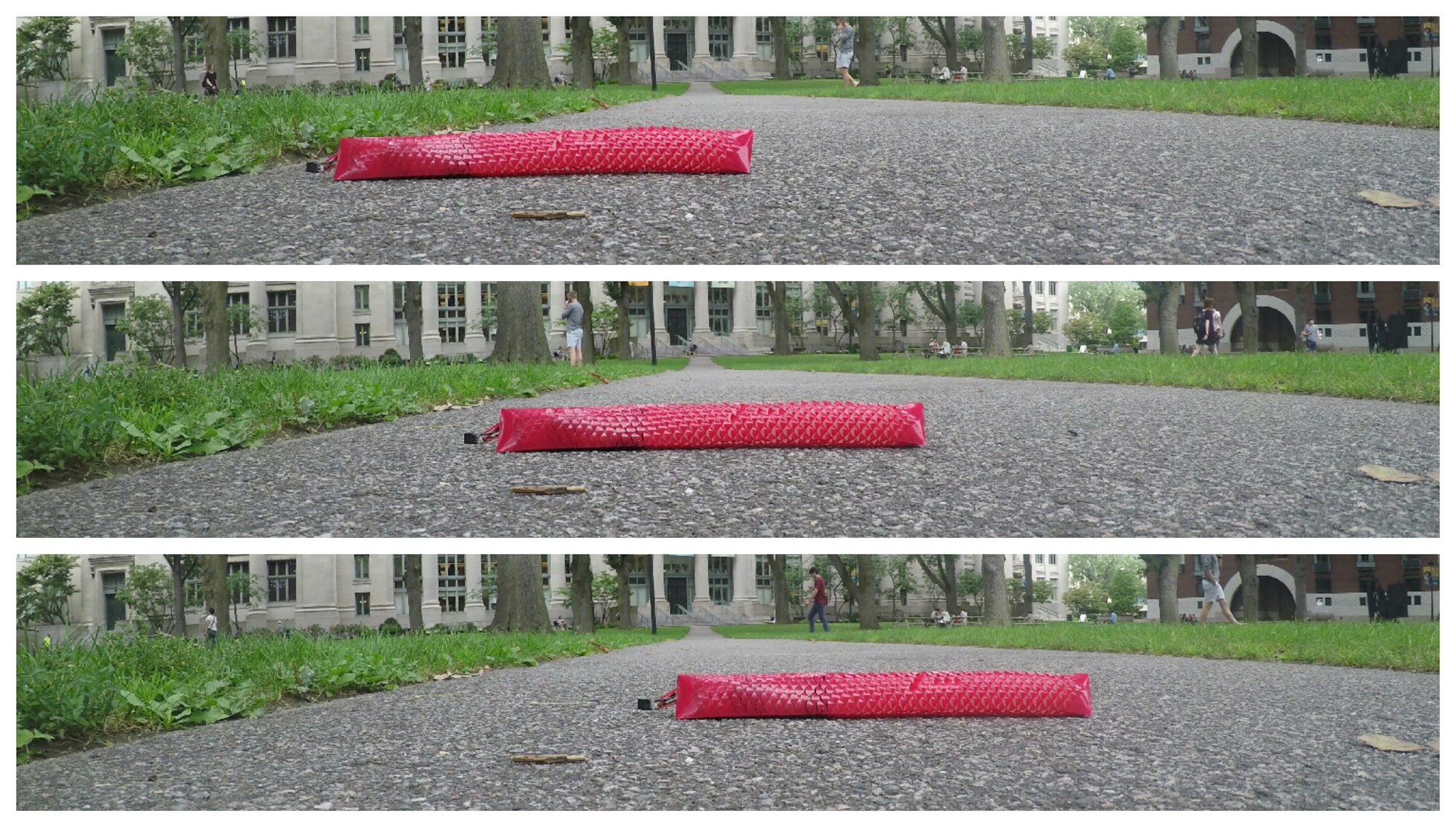
The researchers built a fully untethered robot, with its integrated on-board control, sensing, actuation, and power supply all packed into a tiny tail. They tested it crawling throughout Harvard’s campus.
The team experimented with various-shaped cuts, including triangular, circular, and trapezoidal. They found that trapezoidal cuts — which most closely resemble the shape of snake scales —gave the robot a longer stride.
“We show that the locomotive properties of these kirigami-skins can be harnessed by properly balancing the cut geometry and the actuation protocol,” said Rafsanjani. “Moving forward, these components can be further optimized to improve the response of the system.”
“We believe that our kirigami-based strategy opens avenues for the design of a new class of soft crawlers,” said the paper’s senior author Katia Bertoldi, Ph.D., an Associate Faculty member of the Wyss Institute and the William and Ami Kuan Danoff Professor of Applied Mechanics at SEAS. “These all-terrain soft robots could one day travel across difficult environments for exploration, inspection, monitoring, and search and rescue missions, or perform complex, laparoscopic medical procedures.”
This research was co-authored by Yuerou Zhang; Bangyuan Liu, a visiting student in the Bertoldi lab; and Shmuel M. Rubinstein, Ph.D., Associate Professor of Applied Physics at SEAS. It was supported by the National Science Foundation.
Custom carpentry with help from robots
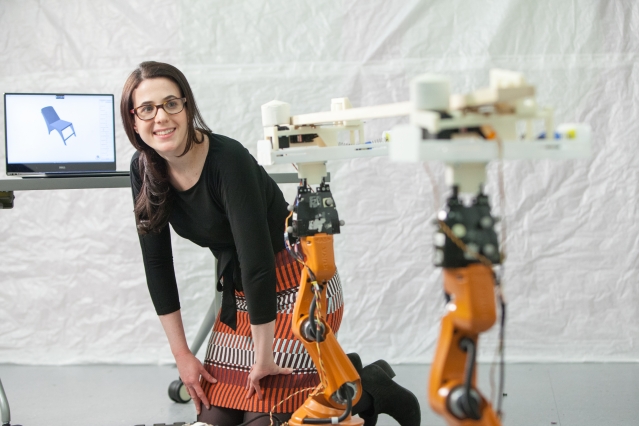
Photo: Jason Dorfman, MIT CSAIL
By Adam Conner-Simons and Rachel Gordon
Every year thousands of carpenters injure their hands and fingers doing dangerous tasks such as sawing.
In an effort to minimize injury and let carpenters focus on design and other bigger-picture tasks, a team from MIT’s Computer Science and Artificial Intelligence Laboratory (CSAIL) has created AutoSaw, a system that lets nonexperts customize different items that can then be constructed with the help of robots.
Users can choose from a range of carpenter-designed templates for chairs, desks, and other furniture. The team says that AutoSaw could eventually be used for projects as large as a deck or a porch.
“If you’re building a deck, you have to cut large sections of lumber to length, and that’s often done on site,” says CSAIL postdoc Jeffrey Lipton, who was a lead author on a related paper about the system. “Every time you put a hand near a blade, you’re at risk. To avoid that, we’ve largely automated the process using a chop-saw and jigsaw.”
The system also offers flexibility for designing furniture to fit space-constrained houses and apartments. For example, it could allow a user to modify a desk to squeeze into an L-shaped living room, or customize a table to fit in a microkitchen.
“Robots have already enabled mass production, but with artificial intelligence (AI) they have the potential to enable mass customization and personalization in almost everything we produce,” says CSAIL director and co-author Daniela Rus. “AutoSaw shows this potential for easy access and customization in carpentry.”
The paper, which will be presented in May at the International Conference on Robotics and Automation (ICRA) in Brisbane, Australia, was co-written by Lipton, Rus, and PhD student Adriana Schulz. Other co-authors include MIT Professor Wojciech Matusik, PhD student Andrew Spielberg, and undergraduate Luis Trueba.
How it works
Software isn’t a foreign concept for some carpenters. “Computer Numerical Control” (CNC) can convert designs into numbers that are fed to specially programmed tools to execute. However, the machines used for CNC fabrication are usually large and cumbersome, and users are limited to the size of the existing CNC tools.
As a result, many carpenters continue to use chop-saws, jigsaws, and other hand tools that are low cost, easy to move, and simple to use. These tools, while useful for customization, still put people at a high risk of injury.
AutoSaw draws on expert knowledge for designing, and robotics for the more risky cutting tasks. Using the existing CAD system OnShape with an interface of design templates, users can customize their furniture for things like size, sturdiness, and aesthetics. Once the design is finalized, it’s sent to the robots to assist in the cutting process using the jigsaw and chop-saw.
To cut lumber the team used motion-tracking software and small mobile robots — an approach that takes up less space and is more cost-effective than large robotic arms.
Specifically, the team used a modified Roomba with a jigsaw attached to cut lumber of any shape on a plank. For the chopping, the team used two Kuka youBots to lift the beam, place it on the chop saw, and cut.
“We added soft grippers to the robots to give them more flexibility, like that of a human carpenter,” says Lipton. “This meant we could rely on the accuracy of the power tools instead of the rigid-bodied robots.”
After the robots finish with cutting, the user then assembles the new piece of furniture using step-by-step directions from the system.
Democratizing custom furniture
When testing the system, the teams’ simulations showed that they could build a chair, shed, and deck. Using the robots, the team also made a table with an accuracy comparable to that of a human, without a real hand ever getting near a blade.
“There have been many recent AI achievements in virtual environments, like playing Go and composing music,” says Hod Lipson, a professor of mechanical engineering and data science at Columbia University. “Systems that can work in unstructured physical environments, such as this carpentry system, are notoriously difficult to make. This is truly a fascinating step forward.”
While AutoSaw is still a research platform, in the future the team plans to use materials such as wood, and integrate complex tasks such as drilling and gluing.
“Our aim is to democratize furniture-customization,” says Schulz. “We’re trying to open up a realm of opportunities so users aren’t bound to what they’ve bought at Ikea. Instead, they can make what best fits their needs.”
The project was supported in part by the National Science Foundation.